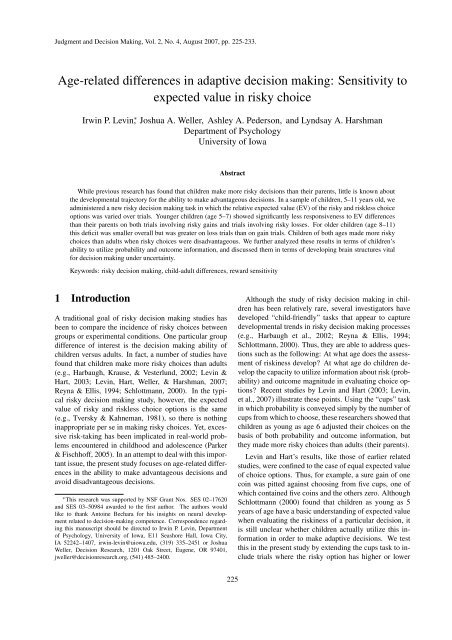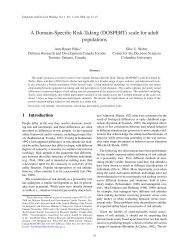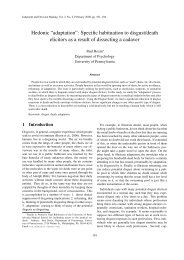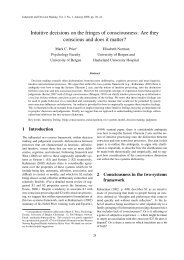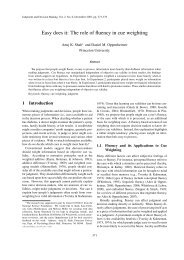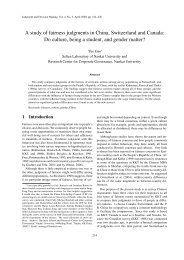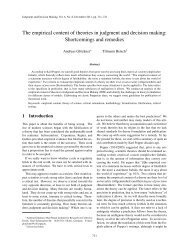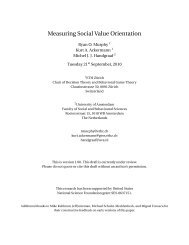Sensitivity to expected value in risky choice - Judgment and ...
Sensitivity to expected value in risky choice - Judgment and ...
Sensitivity to expected value in risky choice - Judgment and ...
You also want an ePaper? Increase the reach of your titles
YUMPU automatically turns print PDFs into web optimized ePapers that Google loves.
<strong>Judgment</strong> <strong>and</strong> Decision Mak<strong>in</strong>g, Vol. 2, No. 4, August 2007, pp. 225-233.<br />
Age-related differences <strong>in</strong> adaptive decision mak<strong>in</strong>g: <strong>Sensitivity</strong> <strong>to</strong><br />
<strong>expected</strong> <strong>value</strong> <strong>in</strong> <strong>risky</strong> <strong>choice</strong><br />
Irw<strong>in</strong> P. Lev<strong>in</strong> ∗ , Joshua A. Weller, Ashley A. Pederson, <strong>and</strong> Lyndsay A. Harshman<br />
Department of Psychology<br />
University of Iowa<br />
Abstract<br />
While previous research has found that children make more <strong>risky</strong> decisions than their parents, little is known about<br />
the developmental trajec<strong>to</strong>ry for the ability <strong>to</strong> make advantageous decisions. In a sample of children, 5–11 years old, we<br />
adm<strong>in</strong>istered a new <strong>risky</strong> decision mak<strong>in</strong>g task <strong>in</strong> which the relative <strong>expected</strong> <strong>value</strong> (EV) of the <strong>risky</strong> <strong>and</strong> riskless <strong>choice</strong><br />
options was varied over trials. Younger children (age 5–7) showed significantly less responsiveness <strong>to</strong> EV differences<br />
than their parents on both trials <strong>in</strong>volv<strong>in</strong>g <strong>risky</strong> ga<strong>in</strong>s <strong>and</strong> trials <strong>in</strong>volv<strong>in</strong>g <strong>risky</strong> losses. For older children (age 8–11)<br />
this deficit was smaller overall but was greater on loss trials than on ga<strong>in</strong> trials. Children of both ages made more <strong>risky</strong><br />
<strong>choice</strong>s than adults when <strong>risky</strong> <strong>choice</strong>s were disadvantageous. We further analyzed these results <strong>in</strong> terms of children’s<br />
ability <strong>to</strong> utilize probability <strong>and</strong> outcome <strong>in</strong>formation, <strong>and</strong> discussed them <strong>in</strong> terms of develop<strong>in</strong>g bra<strong>in</strong> structures vital<br />
for decision mak<strong>in</strong>g under uncerta<strong>in</strong>ty.<br />
Keywords: <strong>risky</strong> decision mak<strong>in</strong>g, child-adult differences, reward sensitivity<br />
1 Introduction<br />
A traditional goal of <strong>risky</strong> decision mak<strong>in</strong>g studies has<br />
been <strong>to</strong> compare the <strong>in</strong>cidence of <strong>risky</strong> <strong>choice</strong>s between<br />
groups or experimental conditions. One particular group<br />
difference of <strong>in</strong>terest is the decision mak<strong>in</strong>g ability of<br />
children versus adults. In fact, a number of studies have<br />
found that children make more <strong>risky</strong> <strong>choice</strong>s than adults<br />
(e.g., Harbaugh, Krause, & Vesterlund, 2002; Lev<strong>in</strong> &<br />
Hart, 2003; Lev<strong>in</strong>, Hart, Weller, & Harshman, 2007;<br />
Reyna & Ellis, 1994; Schlottmann, 2000). In the typical<br />
<strong>risky</strong> decision mak<strong>in</strong>g study, however, the <strong>expected</strong><br />
<strong>value</strong> of <strong>risky</strong> <strong>and</strong> riskless <strong>choice</strong> options is the same<br />
(e.g., Tversky & Kahneman, 1981), so there is noth<strong>in</strong>g<br />
<strong>in</strong>appropriate per se <strong>in</strong> mak<strong>in</strong>g <strong>risky</strong> <strong>choice</strong>s. Yet, excessive<br />
risk-tak<strong>in</strong>g has been implicated <strong>in</strong> real-world problems<br />
encountered <strong>in</strong> childhood <strong>and</strong> adolescence (Parker<br />
& Fischhoff, 2005). In an attempt <strong>to</strong> deal with this important<br />
issue, the present study focuses on age-related differences<br />
<strong>in</strong> the ability <strong>to</strong> make advantageous decisions <strong>and</strong><br />
avoid disadvantageous decisions.<br />
∗ This research was supported by NSF Grant Nos. SES 02–17620<br />
<strong>and</strong> SES 03–50984 awarded <strong>to</strong> the first author. The authors would<br />
like <strong>to</strong> thank An<strong>to</strong><strong>in</strong>e Bechara for his <strong>in</strong>sights on neural development<br />
related <strong>to</strong> decision-mak<strong>in</strong>g competence. Correspondence regard<strong>in</strong>g<br />
this manuscript should be directed <strong>to</strong> Irw<strong>in</strong> P. Lev<strong>in</strong>, Department<br />
of Psychology, University of Iowa, E11 Seashore Hall, Iowa City,<br />
IA 52242–1407, irw<strong>in</strong>-lev<strong>in</strong>@uiowa.edu, (319) 335–2451 or Joshua<br />
Weller, Decision Research, 1201 Oak Street, Eugene, OR 97401,<br />
jweller@decisionresearch.org, (541) 485–2400.<br />
225<br />
Although the study of <strong>risky</strong> decision mak<strong>in</strong>g <strong>in</strong> children<br />
has been relatively rare, several <strong>in</strong>vestiga<strong>to</strong>rs have<br />
developed “child-friendly” tasks that appear <strong>to</strong> capture<br />
developmental trends <strong>in</strong> <strong>risky</strong> decision mak<strong>in</strong>g processes<br />
(e.g., Harbaugh et al., 2002; Reyna & Ellis, 1994;<br />
Schlottmann, 2000). Thus, they are able <strong>to</strong> address questions<br />
such as the follow<strong>in</strong>g: At what age does the assessment<br />
of risk<strong>in</strong>ess develop? At what age do children develop<br />
the capacity <strong>to</strong> utilize <strong>in</strong>formation about risk (probability)<br />
<strong>and</strong> outcome magnitude <strong>in</strong> evaluat<strong>in</strong>g <strong>choice</strong> options?<br />
Recent studies by Lev<strong>in</strong> <strong>and</strong> Hart (2003; Lev<strong>in</strong>,<br />
et al., 2007) illustrate these po<strong>in</strong>ts. Us<strong>in</strong>g the “cups” task<br />
<strong>in</strong> which probability is conveyed simply by the number of<br />
cups from which <strong>to</strong> choose, these researchers showed that<br />
children as young as age 6 adjusted their <strong>choice</strong>s on the<br />
basis of both probability <strong>and</strong> outcome <strong>in</strong>formation, but<br />
they made more <strong>risky</strong> <strong>choice</strong>s than adults (their parents).<br />
Lev<strong>in</strong> <strong>and</strong> Hart’s results, like those of earlier related<br />
studies, were conf<strong>in</strong>ed <strong>to</strong> the case of equal <strong>expected</strong> <strong>value</strong><br />
of <strong>choice</strong> options. Thus, for example, a sure ga<strong>in</strong> of one<br />
co<strong>in</strong> was pitted aga<strong>in</strong>st choos<strong>in</strong>g from five cups, one of<br />
which conta<strong>in</strong>ed five co<strong>in</strong>s <strong>and</strong> the others zero. Although<br />
Schlottmann (2000) found that children as young as 5<br />
years of age have a basic underst<strong>and</strong><strong>in</strong>g of <strong>expected</strong> <strong>value</strong><br />
when evaluat<strong>in</strong>g the risk<strong>in</strong>ess of a particular decision, it<br />
is still unclear whether children actually utilize this <strong>in</strong>formation<br />
<strong>in</strong> order <strong>to</strong> make adaptive decisions. We test<br />
this <strong>in</strong> the present study by extend<strong>in</strong>g the cups task <strong>to</strong> <strong>in</strong>clude<br />
trials where the <strong>risky</strong> option has higher or lower
<strong>Judgment</strong> <strong>and</strong> Decision Mak<strong>in</strong>g, Vol. 2, No. 4, August 2007 Age differences <strong>in</strong> <strong>risky</strong> <strong>choice</strong> 226<br />
<strong>expected</strong> <strong>value</strong> than the riskless or “sure th<strong>in</strong>g” option<br />
(See Weller, Lev<strong>in</strong>, Shiv & Bechara, <strong>in</strong> press, for parallel<br />
application of this methodology <strong>to</strong> bra<strong>in</strong>-lesion patients).<br />
An auxiliary f<strong>in</strong>d<strong>in</strong>g of the Lev<strong>in</strong> <strong>and</strong> Hart studies<br />
was that children’s <strong>risky</strong> <strong>choice</strong>s were less affected by<br />
changes <strong>in</strong> probability level (number of cups from which<br />
<strong>to</strong> choose) than were adults’. With equal <strong>expected</strong> <strong>value</strong><br />
between <strong>choice</strong> options, this result cannot be used <strong>to</strong> <strong>in</strong>fer<br />
decision-mak<strong>in</strong>g deficits <strong>in</strong> children. However, if children<br />
can be shown <strong>to</strong> be less responsive than adults <strong>to</strong> <strong>expected</strong><br />
<strong>value</strong> differences between <strong>choice</strong> options, then a<br />
<strong>value</strong> judgment can be made that children of a certa<strong>in</strong> age<br />
have less developed decision mak<strong>in</strong>g skills than adults, at<br />
least <strong>in</strong> the area of <strong>risky</strong> decision mak<strong>in</strong>g.<br />
In order <strong>to</strong> capture this element of disadvantageous or<br />
“non-adaptive” risk tak<strong>in</strong>g <strong>in</strong> a controlled study, we adm<strong>in</strong>istered<br />
a <strong>risky</strong> <strong>choice</strong> task where the relative <strong>expected</strong><br />
<strong>value</strong> of <strong>risky</strong> <strong>and</strong> riskless <strong>choice</strong> options was varied over<br />
trials. Some trials had equal <strong>expected</strong> <strong>value</strong> for the two<br />
options; some trials had more favorable <strong>expected</strong> <strong>value</strong><br />
for the <strong>risky</strong> option; <strong>and</strong> some trials had more favorable<br />
<strong>expected</strong> <strong>value</strong> for the riskless option. This allowed us<br />
<strong>to</strong> gauge performance not only <strong>in</strong> terms of overall risk<br />
tak<strong>in</strong>g but also <strong>in</strong> terms of sensitivity <strong>to</strong> differences <strong>in</strong> <strong>expected</strong><br />
<strong>value</strong> between <strong>choice</strong> options. We use these measures<br />
of performance <strong>in</strong> a <strong>risky</strong> decision mak<strong>in</strong>g task <strong>to</strong><br />
differentiate between (a) <strong>choice</strong>s of children of two different<br />
age groups <strong>and</strong> <strong>choice</strong>s of adults <strong>and</strong> (b) <strong>choice</strong>s<br />
<strong>in</strong>volv<strong>in</strong>g potential ga<strong>in</strong>s <strong>and</strong> <strong>choice</strong>s <strong>in</strong>volv<strong>in</strong>g potential<br />
losses.<br />
There is some precedence for predict<strong>in</strong>g age-related<br />
developments <strong>in</strong> decision mak<strong>in</strong>g competence. In an earlier<br />
study related <strong>to</strong> the present one <strong>in</strong> terms of children’s<br />
reliance on numerical contextual cues, Jacobs <strong>and</strong><br />
Potenza (1991) studied base rate neglect <strong>in</strong> children of<br />
different ages. Children <strong>in</strong> the first, third, <strong>and</strong> sixth<br />
grades, as well as college students, were asked questions<br />
such as “Which bike should Jim buy?” When base rate<br />
<strong>in</strong>formation said that most people prefer Bike A but <strong>in</strong>dividuat<strong>in</strong>g<br />
<strong>in</strong>formation said that Jim’s neighbor prefers<br />
Bike B, the researchers report that the use of base rates <strong>to</strong><br />
make such <strong>choice</strong>s <strong>in</strong>creased with age <strong>and</strong> that younger<br />
children were more apt <strong>to</strong> use idiosyncratic strategies.<br />
More examples of children’s decision mak<strong>in</strong>g competence<br />
can be found <strong>in</strong> the recent book edited by Jacobs<br />
<strong>and</strong> Klaczynski (2005). In the present study EV is ak<strong>in</strong><br />
<strong>to</strong> base rates <strong>in</strong> that it provides <strong>in</strong>formation regard<strong>in</strong>g the<br />
relative likelihood of different events. Thus, the major<br />
new contribution of the present study is <strong>to</strong> show how children’s<br />
<strong>risky</strong> decision mak<strong>in</strong>g at two different age levels<br />
compares <strong>to</strong> adults, not only <strong>in</strong> terms of overall risk<strong>in</strong>ess,<br />
but also <strong>in</strong> terms of sensitivity <strong>to</strong> <strong>expected</strong> <strong>value</strong> differences<br />
that lead <strong>risky</strong> <strong>choice</strong>s <strong>to</strong> be either advantageous or<br />
disadvantageous.<br />
1.1 Hypotheses<br />
Hypothesis 1. Based on the assumption that risk-tak<strong>in</strong>g<br />
skills develop dur<strong>in</strong>g childhood <strong>and</strong> adolescence (e.g., Jacobs<br />
<strong>and</strong> Potenza, 1991) <strong>and</strong> the specific results of Lev<strong>in</strong><br />
<strong>and</strong> Hart (2003) that children are less responsive <strong>to</strong> probability<br />
differences <strong>in</strong> the cups task than adults, we predict<br />
that children, the younger group <strong>in</strong> particular, will be less<br />
responsive than adults <strong>to</strong> <strong>expected</strong> <strong>value</strong> differences that<br />
render the <strong>risky</strong> <strong>choice</strong> more or less advantageous <strong>in</strong> the<br />
long run.<br />
Hypothesis 2. Related <strong>to</strong> Hypothesis 1 but based on a<br />
separation of fac<strong>to</strong>rs that contribute <strong>to</strong> <strong>expected</strong> <strong>value</strong>, we<br />
predict that the extent <strong>to</strong> which <strong>risky</strong> <strong>choice</strong>s vary as a<br />
function of variations <strong>in</strong> probability <strong>and</strong> outcome magnitude<br />
will be less for children than for adults.<br />
2 Method<br />
2.1 Participants<br />
Participants were 37 children of age 5–7 (range 62–86<br />
months, mean 72.92, SD 6.44, 17 girls, 20 boys), 43 children<br />
of age 8–11 (range 97–134 months, mean 111.61,<br />
SD 15.94, 21 girls, 22 boys), <strong>and</strong> each child’s accompany<strong>in</strong>g<br />
parent (53 mothers, 12 fathers; 11 were parents of<br />
two children <strong>in</strong> the study <strong>and</strong> 2 were parents of three children<br />
<strong>in</strong> the study). Participants were recruited from the<br />
child research participant pool at the University of Iowa<br />
Department of Psychology. Each child-parent pair was<br />
paid $15 plus what they earned <strong>in</strong> the decision mak<strong>in</strong>g<br />
task.<br />
2.2 Procedure<br />
To assess <strong>in</strong>dividuals’ decision propensities under risk,<br />
we used a computerized version of Lev<strong>in</strong> <strong>and</strong> Hart’s<br />
(2003) cups task (Weller et al., <strong>in</strong> press). The cups task<br />
was orig<strong>in</strong>ally designed <strong>to</strong> provide a simple <strong>and</strong> direct<br />
way of depict<strong>in</strong>g probability by merely count<strong>in</strong>g the number<br />
of cups from which <strong>to</strong> choose <strong>in</strong> <strong>risky</strong> decision mak<strong>in</strong>g<br />
(Lev<strong>in</strong> & Hart, 2003). For example, the <strong>risky</strong> option<br />
might require a <strong>choice</strong> between three cups, one of<br />
which conta<strong>in</strong>s co<strong>in</strong>s <strong>and</strong> the other two not. The current<br />
extension <strong>in</strong>cluded manipulation with<strong>in</strong>-participants<br />
of the relative EV of the <strong>risky</strong> <strong>and</strong> riskless options, which<br />
allows the exam<strong>in</strong>ation of a decision maker’s sensitivity<br />
<strong>to</strong> cont<strong>in</strong>gencies that make the <strong>risky</strong> <strong>choice</strong> advantageous<br />
or disadvantageous <strong>in</strong> the long run. We are particularly<br />
<strong>in</strong>terested <strong>in</strong> how children of different ages compare<br />
<strong>to</strong> adults (parents) on this measure, exam<strong>in</strong>ed separately<br />
for <strong>risky</strong> <strong>choice</strong>s <strong>in</strong>volv<strong>in</strong>g potential ga<strong>in</strong>s <strong>and</strong> potential<br />
losses.
<strong>Judgment</strong> <strong>and</strong> Decision Mak<strong>in</strong>g, Vol. 2, No. 4, August 2007 Age differences <strong>in</strong> <strong>risky</strong> <strong>choice</strong> 227<br />
The cups task consisted of 54 trials represent<strong>in</strong>g 3 trials<br />
each of all comb<strong>in</strong>ations of 2 levels of doma<strong>in</strong> (ga<strong>in</strong>,<br />
loss), 3 levels of probability (.20, .33, or .50) <strong>and</strong> 3 levels<br />
of outcome magnitude for the <strong>risky</strong> option (2, 3, or<br />
5 quarters) compared <strong>to</strong> 1 quarter for the riskless option.<br />
Some comb<strong>in</strong>ations of probability <strong>and</strong> magnitude created<br />
equal EV for the <strong>risky</strong> <strong>and</strong> riskless options: .20 x 5, .33 x<br />
3, <strong>and</strong> .50 x 2 on both ga<strong>in</strong> <strong>and</strong> loss trials. Some comb<strong>in</strong>ations<br />
were risk-advantageous <strong>in</strong> the sense that the EV<br />
for the <strong>risky</strong> option was more positive (on ga<strong>in</strong> trials) or<br />
less negative (on loss trials) than the sure ga<strong>in</strong> or loss of<br />
one co<strong>in</strong>: .33 x 5, .50 x 3, .50 x 5 on ga<strong>in</strong> trials; .20<br />
x 2, .20 x 3, .33 x 2 on loss trials. Some comb<strong>in</strong>ations<br />
were risk-disadvantageous <strong>in</strong> the sense that the EV for<br />
the <strong>risky</strong> option was less positive or more negative than<br />
the sure ga<strong>in</strong> or loss: .20 x 2, .20 x 3, .33 x 2 on ga<strong>in</strong><br />
trials; .33 x 5, .50 x 3, .50 x 5 on loss trials. Ga<strong>in</strong> <strong>and</strong><br />
loss trials were presented as blocks, counterbalanced <strong>in</strong><br />
order across participants <strong>in</strong> each group. With<strong>in</strong> a block of<br />
ga<strong>in</strong> or loss trials, probability <strong>and</strong> outcome comb<strong>in</strong>ations<br />
were presented <strong>in</strong> r<strong>and</strong>om order <strong>and</strong> the left-right position<br />
of riskless <strong>and</strong> <strong>risky</strong> options was also r<strong>and</strong>omized.<br />
All participants were <strong>in</strong>dividually tested dur<strong>in</strong>g a 20<br />
m<strong>in</strong>ute session. Parents <strong>in</strong>dependently completed the exact<br />
same task as the children <strong>and</strong> were given the same<br />
<strong>in</strong>structions verbatim. The task performed by both parent<br />
<strong>and</strong> child was adm<strong>in</strong>istered us<strong>in</strong>g a computer game<br />
specifically designed for this experiment. The computer<br />
task was presented as a game of chance <strong>in</strong> which participants<br />
could w<strong>in</strong> or lose quarters which were displayed on<br />
the computer screen. To help simulate the effects of us<strong>in</strong>g<br />
real money, participants were <strong>in</strong>formed that based on<br />
the f<strong>in</strong>al score on the computer game, they would receive<br />
actual monetary compensation determ<strong>in</strong>ed by a po<strong>in</strong>tsbased<br />
pay scale.<br />
Ga<strong>in</strong> trials <strong>in</strong>volved the <strong>choice</strong> between an option that<br />
offered a sure ga<strong>in</strong> of one quarter <strong>and</strong> another option<br />
that offered a designated probability of w<strong>in</strong>n<strong>in</strong>g multiple<br />
quarters or no quarters. Loss trials <strong>in</strong>volved the <strong>choice</strong><br />
between a sure loss of one quarter <strong>and</strong> a designated probability<br />
of los<strong>in</strong>g multiple quarters or no quarters. Participants<br />
started the block of loss trials with enough quarters<br />
<strong>in</strong> the bank <strong>to</strong> ensure that they would not end up with a<br />
los<strong>in</strong>g <strong>to</strong>tal. On each trial, an array of 2, 3, or 5 cups<br />
was shown on each side of the screen. One array was<br />
identified as the certa<strong>in</strong> side where one quarter would be<br />
ga<strong>in</strong>ed (lost) for whichever cup was selected. The other<br />
array was identified as the <strong>risky</strong> side where the selection<br />
of one cup would lead <strong>to</strong> a designated number of quarters<br />
ga<strong>in</strong>ed (lost) <strong>and</strong> the other cups would lead <strong>to</strong> no<br />
ga<strong>in</strong> (loss). At the bot<strong>to</strong>m of the screen was a depiction<br />
of a bank where co<strong>in</strong>s were shown be<strong>in</strong>g added <strong>to</strong><br />
(subtracted from) the decision maker’s account. The outcome<br />
on each trial depended on which side was selected<br />
<strong>and</strong>, if it was the <strong>risky</strong> side, the <strong>choice</strong> of one cup determ<strong>in</strong>ed<br />
whether quarters were added (taken away). A r<strong>and</strong>om<br />
process with p = 1/(number of cups) determ<strong>in</strong>ed<br />
whether the <strong>risky</strong> <strong>choice</strong> led <strong>to</strong> a ga<strong>in</strong> (loss). When the<br />
participant completed all 54 trials, their <strong>to</strong>tal amount won<br />
appeared on the screen. Participants were compensated<br />
based on the money that they won on the task.<br />
2.3 Statistical plan<br />
Our research design allowed two levels of analysis of<br />
decision mak<strong>in</strong>g under risk. First, <strong>to</strong> measure how participants<br />
adapted <strong>to</strong> differences <strong>in</strong> EV between riskless<br />
<strong>and</strong> <strong>risky</strong> options, we calculated the percentage of <strong>risky</strong><br />
<strong>choice</strong>s at each of the three EV levels: risk advantageous<br />
trials (RA; the EV of the <strong>risky</strong> <strong>choice</strong> was more favorable<br />
than that of the riskless <strong>choice</strong>), equal EV trials<br />
(EQEV; the EVs for the riskless <strong>and</strong> <strong>risky</strong> option were<br />
equal), <strong>and</strong> risk disadvantageous trials (RD; the EV was<br />
more favorable for the riskless option than the <strong>risky</strong> option).<br />
These measures were computed separately for the<br />
ga<strong>in</strong> <strong>and</strong> loss doma<strong>in</strong> <strong>and</strong> are particularly important for<br />
identify<strong>in</strong>g when children’s decisions are less advantageous/more<br />
disadvantageous than adults.<br />
Second, because we fac<strong>to</strong>rially manipulated probability<br />
level <strong>and</strong> outcome magnitude level for the <strong>risky</strong> option<br />
<strong>in</strong> each doma<strong>in</strong>, we were able <strong>to</strong> assess how each<br />
of these components of EV <strong>in</strong>dependently affected <strong>risky</strong><br />
<strong>choice</strong>. This is particularly important for underst<strong>and</strong><strong>in</strong>g<br />
children’s ability <strong>to</strong> utilize these two sources of <strong>in</strong>formation.<br />
3 Results<br />
3.1 Adaptive <strong>risky</strong> decision mak<strong>in</strong>g<br />
Figure 1 displays the proportion of <strong>risky</strong> <strong>choice</strong>s for each<br />
child age group <strong>and</strong> adults as a function of EV level, plotted<br />
<strong>in</strong> separate panels for ga<strong>in</strong> trials <strong>and</strong> loss trials. The<br />
elevation of l<strong>in</strong>es <strong>in</strong> each panel represents level of risktak<strong>in</strong>g,<br />
the slopes of the l<strong>in</strong>es represent responsiveness <strong>to</strong><br />
<strong>expected</strong> <strong>value</strong> differences, <strong>and</strong> the differences between<br />
the two panels represent doma<strong>in</strong> (ga<strong>in</strong> vs. loss) effects.<br />
The major trends observed <strong>in</strong> Figure 1 are: (1) Consistent<br />
with Hypothesis 1, younger children were substantially<br />
less responsive than their parents <strong>to</strong> <strong>expected</strong> <strong>value</strong> differences<br />
on both ga<strong>in</strong> <strong>and</strong> loss trials, with the net result<br />
be<strong>in</strong>g a much smaller difference <strong>in</strong> the proportion of risks<br />
taken on risk advantageous versus risk disadvantageous<br />
trials by the children; (2) also consistent with Hypothesis<br />
1 but with doma<strong>in</strong>-specific effects, the older children<br />
displayed results <strong>in</strong>termediate between those of younger<br />
children <strong>and</strong> adults. While they showed approximately
<strong>Judgment</strong> <strong>and</strong> Decision Mak<strong>in</strong>g, Vol. 2, No. 4, August 2007 Age differences <strong>in</strong> <strong>risky</strong> <strong>choice</strong> 228<br />
Proportion <strong>risky</strong> <strong>choice</strong>s<br />
Proportion <strong>risky</strong> <strong>choice</strong>s<br />
0.3 0.4 0.5 0.6 0.7 0.8 0.9 1.0<br />
0.3 0.4 0.5 0.6 0.7 0.8 0.9 1.0<br />
A. Ga<strong>in</strong> doma<strong>in</strong><br />
Older children<br />
RA EQEV RD<br />
B. Loss doma<strong>in</strong><br />
Younger children<br />
EV level<br />
EV level<br />
Younger children<br />
Adults<br />
Older children<br />
Adults<br />
RA EQEV RD<br />
Figure 1: Adaptive decision mak<strong>in</strong>g as a function of age,<br />
doma<strong>in</strong>, <strong>and</strong> EV level. RA = Risk Advantageous trials.<br />
EQEV = Equal Expected Value trials. RD = Risk Disadvantageous<br />
trials.<br />
the same sensitivity <strong>to</strong> EV differences as their parents on<br />
ga<strong>in</strong> trials, they showed much less responsiveness <strong>to</strong> EV<br />
differences on loss trials. (3) In terms of overall risktak<strong>in</strong>g,<br />
we observed that older children made more <strong>risky</strong><br />
<strong>choice</strong>s than their parents. In contrast, we did not f<strong>in</strong>d that<br />
younger children’s overall risk tak<strong>in</strong>g was greater than either<br />
their parents or older children. However, children of<br />
both age groups were especially apt <strong>to</strong> make more <strong>risky</strong><br />
Table 1: Summary of analysis of variance tests for responsiveness<br />
<strong>to</strong> EV differences<br />
Source df SS F Significance<br />
Age group 2, 142 0.66 1.64 .197<br />
EV level 2, 284 4.77 57.01 < .001<br />
Doma<strong>in</strong> 1, 142 0.00 0.13 .910<br />
Group x EV 4, 284 1.85 11.03 < .001<br />
Group x Doma<strong>in</strong> 2, 142 0.41 2.54 .083<br />
EV x Doma<strong>in</strong> 2, 284 0.21 3.57 .030<br />
Group x EV x Doma<strong>in</strong> 4, 284 0.09 0.73 .575<br />
<strong>choice</strong>s than their parents on trials <strong>in</strong> which it was disadvantageous<br />
<strong>in</strong> the long run <strong>to</strong> take a risk. (4) Only adults<br />
displayed the classic preference shift (Tversky & Kahneman,<br />
1981) of more <strong>risky</strong> <strong>choice</strong>s <strong>to</strong> avoid a loss than <strong>to</strong><br />
achieve a ga<strong>in</strong> across all EV levels.<br />
An ANOVA was conducted <strong>to</strong> support these observations<br />
where the fac<strong>to</strong>rs were age group (younger children,<br />
older children, adults), EV level (RA vs. EQEV vs. RD<br />
trials), <strong>and</strong> ga<strong>in</strong>/loss doma<strong>in</strong>. Results are summarized <strong>in</strong><br />
Table 1. The most important age-related results were a<br />
significant <strong>in</strong>teraction (p < .001) between age group <strong>and</strong><br />
EV level, <strong>and</strong> an <strong>in</strong>teraction between age group <strong>and</strong> doma<strong>in</strong><br />
that approached significance (p < .10). Several<br />
specific contrasts were conducted <strong>to</strong> follow up these results.<br />
The age group by EV level <strong>in</strong>teraction was broken<br />
down <strong>in</strong><strong>to</strong> the follow<strong>in</strong>g four <strong>in</strong>dependent contrasts:<br />
younger children vs. adults on ga<strong>in</strong> trials, younger children<br />
vs. adults on loss trials, older children vs. adults on<br />
ga<strong>in</strong> trials, older children vs. adults on loss trials. A Bonferroni<br />
correction was applied <strong>and</strong> thus significance level<br />
was adjusted <strong>to</strong> p < .01. Younger children were significantly<br />
less responsive <strong>to</strong> differences <strong>in</strong> relative EV between<br />
options than adults on both ga<strong>in</strong> <strong>and</strong> loss trials,<br />
F (2, 202) = 10.60 <strong>and</strong> 10.41, p < .001 for the ga<strong>in</strong><br />
<strong>and</strong> loss doma<strong>in</strong>, respectively. Older children were significantly<br />
less responsive <strong>to</strong> EV level than adults on loss<br />
trials, F (2, 212) = 6.68, p < .01, but not on ga<strong>in</strong> trials,<br />
F (2, 212) = 1.99, p = .14.<br />
Furthermore, irrespective of doma<strong>in</strong>, younger children<br />
were not only more likely <strong>to</strong> take risks than their parents<br />
when it was disadvantageous <strong>to</strong> do so (RD trials),<br />
t(100) = 2.94, p < .01, but they were also less likely<br />
<strong>to</strong> take risks when it was advantageous <strong>to</strong> do so (RA<br />
trials), t(100) = −2.62, p < .01. Older children <strong>to</strong>ok<br />
significantly more risks on RD trials than their parents<br />
t(106)=2.85, p < .01 but there was no significant difference<br />
on RA trials, t(106)=−.30, p=.76.
<strong>Judgment</strong> <strong>and</strong> Decision Mak<strong>in</strong>g, Vol. 2, No. 4, August 2007 Age differences <strong>in</strong> <strong>risky</strong> <strong>choice</strong> 229<br />
3.2 Preference shifts<br />
With respect <strong>to</strong> doma<strong>in</strong>-specific differences <strong>in</strong> riskpreference,<br />
we conducted three parallel paired-samples<br />
t-tests <strong>to</strong> exam<strong>in</strong>e the preference shift <strong>in</strong> children <strong>and</strong><br />
adults. Indeed, we found that adults exhibited the traditional<br />
pattern of more risk-tak<strong>in</strong>g <strong>in</strong> losses (M =<br />
17.32, SD = 6.31) than <strong>in</strong> ga<strong>in</strong>s (M = 18.5, SD =<br />
6.44,t(64) = 1.73, p < .05, one-tailed). In contrast, neither<br />
child group showed such an effect, t(36) = 1.36 <strong>and</strong><br />
t(42) = .73, ns, for younger <strong>and</strong> older children, respectively.<br />
3.3 Responsiveness <strong>to</strong> probability <strong>and</strong> outcome<br />
<strong>in</strong>formation<br />
Age-related differences <strong>in</strong> response <strong>to</strong> EV variations were<br />
further broken down <strong>in</strong><strong>to</strong> the <strong>in</strong>dependent effects of probability<br />
<strong>and</strong> outcome <strong>in</strong>formation. The fac<strong>to</strong>rial manipulation<br />
of probability level <strong>and</strong> outcome magnitude with<strong>in</strong><br />
each doma<strong>in</strong> for each age group allowed us <strong>to</strong> exam<strong>in</strong>e<br />
risk tak<strong>in</strong>g as a function of probability level (.50, .33,<br />
.20), outcome magnitude (2, 3, or 5 quarters at stake<br />
with a <strong>risky</strong> <strong>choice</strong>), <strong>and</strong> ga<strong>in</strong>/loss doma<strong>in</strong>. These results,<br />
summarized <strong>in</strong> Figure 2, are supportive of H2. As<br />
plotted <strong>in</strong> Figure 2, risk tak<strong>in</strong>g on ga<strong>in</strong> trials should <strong>in</strong>crease<br />
with <strong>in</strong>creas<strong>in</strong>g probability <strong>and</strong> <strong>in</strong>creas<strong>in</strong>g outcome<br />
magnitude. Conversely, risk tak<strong>in</strong>g on loss trials<br />
should decrease with <strong>in</strong>creas<strong>in</strong>g probability <strong>and</strong> <strong>in</strong>creas<strong>in</strong>g<br />
outcome magnitude which <strong>in</strong> this case is negative.<br />
The slopes <strong>and</strong> separation of l<strong>in</strong>es <strong>in</strong> each panel display<br />
the size of these effects for each age group-doma<strong>in</strong> comb<strong>in</strong>ation.<br />
We start with the adults because they represent the<br />
“basel<strong>in</strong>e” comparison for the children. As <strong>expected</strong>,<br />
adults show large effects of probability <strong>and</strong> outcome<br />
magnitude on both ga<strong>in</strong> <strong>and</strong> loss trials. However, their responses<br />
do not conform exactly <strong>to</strong> the patterns predicted<br />
by the normative multiplicative model of probability-byoutcome<br />
(assum<strong>in</strong>g that proportion of <strong>risky</strong> <strong>choice</strong>s depends<br />
l<strong>in</strong>early on the EV of that <strong>choice</strong>). This model predicts<br />
a fan of l<strong>in</strong>es that diverge upward <strong>to</strong> the right <strong>in</strong> the<br />
case of ga<strong>in</strong>s <strong>and</strong> diverge downward <strong>to</strong> the right <strong>in</strong> the<br />
case of losses (Anderson, 1991). Only the loss pattern<br />
conforms.<br />
The panels for the younger children show an irregular<br />
pattern. On ga<strong>in</strong> trials the children made the most<br />
<strong>risky</strong> <strong>choice</strong>s when the amount <strong>to</strong> be won was greatest<br />
<strong>and</strong> on loss trials they made the least <strong>risky</strong> <strong>choice</strong>s when<br />
the amount <strong>to</strong> be lost was greatest. As a group, however,<br />
they were clearly not responsive <strong>to</strong> differences <strong>in</strong> probability<br />
level. Consistent with our earlier analyses, the older<br />
children were like adults on ga<strong>in</strong> trials, display<strong>in</strong>g differences<br />
<strong>in</strong> risk tak<strong>in</strong>g as a function of both probability <strong>and</strong><br />
Table 2: Mean regression weights predict<strong>in</strong>g <strong>risky</strong><br />
<strong>choice</strong>s as a function of age group, probability level, <strong>and</strong><br />
outcome magnitude.<br />
Source Mean St<strong>and</strong>ard<br />
coefficient 1 error<br />
Younger children<br />
Ga<strong>in</strong> Doma<strong>in</strong><br />
Probability .023 .011<br />
Outcome .030 .014<br />
Older children<br />
Probability .049 .011<br />
Outcome .056 .010<br />
Adults<br />
Probability .095 .015<br />
Outcome .066 .010<br />
Younger children<br />
Loss Doma<strong>in</strong><br />
Probability −.002 .011<br />
Outcome .017 .013<br />
Older children<br />
Probability .027 .011<br />
Outcome .031 .011<br />
Adults<br />
Probability .060 .015<br />
Outcome .089 .012<br />
1. Signs are positive when participants<br />
responded accord<strong>in</strong>g <strong>to</strong> EV.<br />
outcome magnitude. On loss trials they were like adults<br />
<strong>in</strong> respond<strong>in</strong>g <strong>to</strong> extreme outcomes, but showed irregular<br />
respond<strong>in</strong>g <strong>to</strong> the <strong>in</strong>termediate outcome level.<br />
For each participant, we regressed <strong>risky</strong> <strong>choice</strong> (1 or 0)<br />
aga<strong>in</strong>st outcome <strong>and</strong> probability of w<strong>in</strong>n<strong>in</strong>g, separately<br />
for ga<strong>in</strong>s <strong>and</strong> losses. (Actually, <strong>in</strong>stead of probability, we<br />
used its reciprocal, the number of cups, which provided<br />
a slightly better fit.) Note that we are not carry<strong>in</strong>g out<br />
significance tests on <strong>in</strong>dividual participants. Rather, we
<strong>Judgment</strong> <strong>and</strong> Decision Mak<strong>in</strong>g, Vol. 2, No. 4, August 2007 Age differences <strong>in</strong> <strong>risky</strong> <strong>choice</strong> 230<br />
Proportion <strong>risky</strong> <strong>choice</strong>s<br />
Proportion <strong>risky</strong> <strong>choice</strong>s<br />
Proportion <strong>risky</strong> <strong>choice</strong>s<br />
0.3 0.4 0.5 0.6 0.7 0.8 0.9 1.0<br />
0.3 0.4 0.5 0.6 0.7 0.8 0.9 1.0<br />
0.3 0.4 0.5 0.6 0.7 0.8 0.9 1.0<br />
Ga<strong>in</strong>s, younger children<br />
0.2 0.33 0.5<br />
Ga<strong>in</strong>s, older children<br />
Probability of w<strong>in</strong>n<strong>in</strong>g<br />
$0.50<br />
$0.75<br />
$1.25<br />
0.2 0.33 0.5<br />
Ga<strong>in</strong>s, adults<br />
Probability of w<strong>in</strong>n<strong>in</strong>g<br />
0.2 0.33 0.5<br />
Probability of w<strong>in</strong>n<strong>in</strong>g<br />
Proportion <strong>risky</strong> <strong>choice</strong>s<br />
Proportion <strong>risky</strong> <strong>choice</strong>s<br />
Proportion <strong>risky</strong> <strong>choice</strong>s<br />
0.3 0.4 0.5 0.6 0.7 0.8 0.9 1.0<br />
0.3 0.4 0.5 0.6 0.7 0.8 0.9 1.0<br />
0.3 0.4 0.5 0.6 0.7 0.8 0.9 1.0<br />
Losses, younger children<br />
0.2 0.33 0.5<br />
Losses, older children<br />
Probability of w<strong>in</strong>n<strong>in</strong>g<br />
Probability of w<strong>in</strong>n<strong>in</strong>g<br />
$0.50<br />
$0.75<br />
$1.25<br />
0.2 0.33 0.5<br />
Losses, adults<br />
0.2 0.33 0.5<br />
Probability of w<strong>in</strong>n<strong>in</strong>g<br />
Figure 2: Risk tak<strong>in</strong>g as a function of outcome, probability level, <strong>and</strong> age group.
<strong>Judgment</strong> <strong>and</strong> Decision Mak<strong>in</strong>g, Vol. 2, No. 4, August 2007 Age differences <strong>in</strong> <strong>risky</strong> <strong>choice</strong> 231<br />
are exam<strong>in</strong><strong>in</strong>g these regression coefficients, which simply<br />
represent the effect of each variable on the proportion<br />
of <strong>risky</strong> <strong>choice</strong>s for each participant. The <strong>in</strong>dependent<br />
variables were orthogonal.<br />
Table 2 provides results, means <strong>and</strong> st<strong>and</strong>ard deviations,<br />
for the analyses. Upon <strong>in</strong>spection of this table, one<br />
can see several <strong>in</strong>terest<strong>in</strong>g trends. In the ga<strong>in</strong> doma<strong>in</strong>,<br />
adults, as <strong>expected</strong>, were able <strong>to</strong> adjust their <strong>choice</strong>s<br />
based on variations of both probability <strong>and</strong> outcome magnitude.<br />
Older children also displayed sensitivity <strong>to</strong> these<br />
contextual cues, albeit <strong>to</strong> a lesser degree than adults, <strong>and</strong><br />
younger children used the cues even less. Younger children<br />
did not systematically use probability or outcome<br />
magnitude when try<strong>in</strong>g <strong>to</strong> avoid a loss.<br />
In the light of these f<strong>in</strong>d<strong>in</strong>gs, we tested the degree of<br />
consistency <strong>in</strong> responses for children <strong>and</strong> adults. Children,<br />
especially the younger children, were less consistent<br />
overall. In particular, children were more likely <strong>to</strong><br />
violate dom<strong>in</strong>ance. For example, if a participant chooses<br />
the gamble (<strong>in</strong> ga<strong>in</strong>s) for 2 cups <strong>and</strong> 2 quarters, but does<br />
not choose it for 2 cups <strong>and</strong> 3 quarters, that is a violation.<br />
The percent of violations (out of the possible violations<br />
that could occur) <strong>in</strong> the ga<strong>in</strong>s doma<strong>in</strong> were 16%, 11% <strong>and</strong><br />
8% for younger children, older children, <strong>and</strong> adults, respectively.<br />
The respective percents for losses were 16%,<br />
12% <strong>and</strong> 8%. All age differences were highly significant.<br />
Moreover, the lack of consistency did not result at all<br />
from across-participant variability <strong>in</strong> the relative weights<br />
of probability <strong>and</strong> outcome. If anyth<strong>in</strong>g, adults were<br />
more variable than children <strong>in</strong> the with<strong>in</strong>-participant difference<br />
between the weight of probability <strong>and</strong> that of outcome,<br />
but the differences <strong>in</strong> variability were small.<br />
Tak<strong>in</strong>g all the analyses <strong>to</strong>gether, these results demonstrate<br />
that the younger children were the most impaired<br />
<strong>in</strong> their <strong>risky</strong> decision mak<strong>in</strong>g. They were the group least<br />
responsive <strong>to</strong> EV differences between <strong>risky</strong> <strong>and</strong> riskless<br />
<strong>choice</strong> options. At a more microscopic level, the younger<br />
children were the least responsive <strong>to</strong> changes <strong>in</strong> the components<br />
of EV, especially <strong>in</strong> probability level. This occurred<br />
both on those trials <strong>in</strong> which a <strong>risky</strong> <strong>choice</strong> could<br />
lead <strong>to</strong> a substantial loss <strong>and</strong> those trials where a <strong>risky</strong><br />
<strong>choice</strong> had a high probability of zero ga<strong>in</strong>. For older children,<br />
results were mixed. They were clearly responsive<br />
<strong>to</strong> EV differences <strong>and</strong> probability <strong>and</strong> outcome magnitude<br />
differences on ga<strong>in</strong> trials. Nevertheless, when coupled<br />
with overall greater risk-tak<strong>in</strong>g, the result was that<br />
these children still made more <strong>risky</strong> <strong>choice</strong>s than adults<br />
on risk-disadvantageous ga<strong>in</strong> trials. It was <strong>in</strong> the doma<strong>in</strong><br />
of losses, however, where the responses of this group particularly<br />
deviated from those of their parents. The extent<br />
<strong>to</strong> which older children adjusted their <strong>risky</strong> <strong>choice</strong>s based<br />
on EV differences was much less than their parents’ adjustments.<br />
While older children showed evidence of a<br />
more ref<strong>in</strong>ed decision strategy compared <strong>to</strong> their younger<br />
counterparts, both groups of children made substantially<br />
more than 50% <strong>risky</strong> <strong>choice</strong>s even when it was disadvantageous<br />
<strong>to</strong> do so.<br />
4 Discussion<br />
The major contribution of this study is <strong>to</strong> directly test<br />
for age-related differences <strong>in</strong> the ability <strong>to</strong> make <strong>choice</strong>s<br />
which take <strong>in</strong><strong>to</strong> account differences <strong>in</strong> <strong>expected</strong> <strong>value</strong> between<br />
<strong>choice</strong> options. Through our methodology, we uncovered<br />
differences between the way children of different<br />
ages <strong>and</strong> adults react <strong>to</strong> <strong>risky</strong> decision mak<strong>in</strong>g. While<br />
the task was presented as a game of chance us<strong>in</strong>g “house<br />
money” <strong>and</strong> consequently there may have been a premium<br />
on mak<strong>in</strong>g <strong>risky</strong> <strong>choice</strong>s (see Lev<strong>in</strong> et al., 2007),<br />
we nevertheless found that adults <strong>and</strong> older children made<br />
more <strong>risky</strong> <strong>choice</strong>s when it was advantageous <strong>to</strong> do so<br />
than when it was disadvantageous.<br />
As <strong>expected</strong>, adults were the most able <strong>to</strong> adjust their<br />
risk-tak<strong>in</strong>g based on EV differences between <strong>choice</strong> options<br />
<strong>in</strong> both ga<strong>in</strong> <strong>and</strong> loss doma<strong>in</strong>s while the youngest<br />
age group was the least able <strong>to</strong> do this. Older children<br />
demonstrated an <strong>in</strong>termediate level of adaptive decision<br />
mak<strong>in</strong>g. Specifically, older children displayed a sensitivity<br />
<strong>to</strong> EV differences <strong>in</strong> the ga<strong>in</strong> doma<strong>in</strong>, but much less<br />
so <strong>in</strong> the loss doma<strong>in</strong>.<br />
On the basis of earlier studies, the current authors<br />
(Lev<strong>in</strong>, et al., 2007) <strong>and</strong> others (e.g., Harbaugh, et al.,<br />
2002; Reyna & Ellis, 1994; Rice, 1995; Schlottmann &<br />
Tr<strong>in</strong>g, 2005) concluded that young children possess the<br />
basic underst<strong>and</strong><strong>in</strong>g <strong>and</strong> ability <strong>to</strong> consider both probability<br />
<strong>and</strong> outcome <strong>in</strong>formation <strong>in</strong> mak<strong>in</strong>g <strong>risky</strong> <strong>choice</strong>s.<br />
However, earlier studies did not require decision makers<br />
<strong>to</strong> discrim<strong>in</strong>ate between situations <strong>in</strong> which <strong>in</strong> the long<br />
run it was advantageous or disadvantageous <strong>to</strong> make <strong>risky</strong><br />
<strong>choice</strong>s. Present results, related <strong>to</strong> the earlier f<strong>in</strong>d<strong>in</strong>g<br />
that children were less responsive than adults <strong>to</strong> changes<br />
<strong>in</strong> probability (Lev<strong>in</strong> & Hart, 2003), clearly show that<br />
younger children are less able than adults <strong>to</strong> use probability<br />
<strong>in</strong>formation <strong>to</strong> discrim<strong>in</strong>ate between advantageous<br />
<strong>and</strong> disadvantageous <strong>risky</strong> <strong>choice</strong>s.<br />
These results seem <strong>to</strong> suggest a cont<strong>in</strong>uum from nonsystematic<br />
<strong>to</strong> systematic respond<strong>in</strong>g <strong>to</strong> the components of<br />
<strong>risky</strong> <strong>choice</strong> across age groups. The risk tak<strong>in</strong>g of adults,<br />
who were benchmarks for assess<strong>in</strong>g children’s decision<br />
mak<strong>in</strong>g, clearly depended on the relative <strong>expected</strong> <strong>value</strong><br />
of <strong>choice</strong> options <strong>and</strong> the components of EV, probability<br />
<strong>and</strong> outcome magnitude. At the other extreme, younger<br />
children showed signs of respond<strong>in</strong>g on the basis of an<br />
overall preference for risk, with only slight adjustment<br />
<strong>to</strong> the particular circumstances of any s<strong>in</strong>gle <strong>risky</strong> <strong>choice</strong><br />
even when the probability of an unfavorable outcome was<br />
great. What appears <strong>to</strong> be the case is that children <strong>and</strong>
<strong>Judgment</strong> <strong>and</strong> Decision Mak<strong>in</strong>g, Vol. 2, No. 4, August 2007 Age differences <strong>in</strong> <strong>risky</strong> <strong>choice</strong> 232<br />
adults respond <strong>to</strong> a <strong>risky</strong> <strong>choice</strong> on the basis of an underly<strong>in</strong>g<br />
attitude <strong>to</strong> seek or avoid risks which is probably<br />
primarily emotional <strong>in</strong> nature, <strong>and</strong> then adjust employ<strong>in</strong>g<br />
a computational process operat<strong>in</strong>g on probabilities<br />
<strong>and</strong> outcomes. Age-related maturation clearly affects the<br />
computational component. Results with the older children<br />
reveal the possibility that this maturation may occur<br />
at different rates for deal<strong>in</strong>g with <strong>risky</strong> ga<strong>in</strong>s <strong>and</strong> <strong>risky</strong><br />
losses.<br />
Such f<strong>in</strong>d<strong>in</strong>gs concern<strong>in</strong>g age-related differences <strong>in</strong><br />
adaptive decision mak<strong>in</strong>g can add <strong>to</strong> research <strong>in</strong> developmental<br />
neuropsychology which suggests that dur<strong>in</strong>g<br />
childhood <strong>and</strong> adolescence there are pronounced changes<br />
<strong>in</strong> patterns of decision mak<strong>in</strong>g which may be heavily<br />
<strong>in</strong>fluenced by affective processes, especially the ability<br />
<strong>to</strong> anticipate the future consequences of one’s actions<br />
(Crone, Vendel, & Van der Molen, 2003). Researchers<br />
have associated these changes with functional maturation<br />
of the prefrontal cortex, which is presumed <strong>to</strong> be the<br />
latest <strong>to</strong> functionally mature (Luna & Sweeney, 2001).<br />
With such immaturity comes less ability for affective control<br />
(mediated by the ventromedial prefrontal cortex or<br />
VMPC), which may lead <strong>to</strong> impaired decision mak<strong>in</strong>g<br />
(Bechara, Damasio, Damasio, & Lee, 1999). In fact,<br />
Weller et al. (<strong>in</strong> press) found that <strong>in</strong>dividuals with bilateral<br />
VMPC lesions, much like the younger children <strong>in</strong><br />
the present study, demonstrated a pattern of non-adaptive<br />
decision mak<strong>in</strong>g, tak<strong>in</strong>g risks without regards <strong>to</strong> EV differences<br />
<strong>in</strong> both the ga<strong>in</strong> <strong>and</strong> loss doma<strong>in</strong> of the cups task.<br />
Future research may be able <strong>to</strong> track how different stages<br />
of neural development separately impact the emotional<br />
<strong>and</strong> cognitive components of adaptive decision mak<strong>in</strong>g.<br />
Additionally, our results re<strong>in</strong>force research from a variety<br />
of areas which strongly suggests that negative <strong>in</strong>formation<br />
<strong>and</strong> positive <strong>in</strong>formation <strong>in</strong>volve different process<strong>in</strong>g<br />
resources (for a review, see Baumeister, Bratslavsky,<br />
F<strong>in</strong>kenauer, & Vohs, 2001). Our f<strong>in</strong>d<strong>in</strong>g that both<br />
child groups performed sub-optimally <strong>in</strong> the loss doma<strong>in</strong><br />
even when older children showed signs of adult-like sensitivities<br />
<strong>in</strong> the ga<strong>in</strong> doma<strong>in</strong> may <strong>in</strong>dicate that risk seek<strong>in</strong>g<br />
<strong>in</strong> the loss doma<strong>in</strong> is an early learned decision strategy<br />
(see Reyna, 1996). There are, however, situations <strong>in</strong> everyday<br />
life <strong>in</strong> which the sacrifice <strong>in</strong>curred by a sure but<br />
small loss benefits the decision maker <strong>in</strong> the long run by<br />
avoid<strong>in</strong>g even larger losses. We propose that these types<br />
of decisions, like those on RD loss trials <strong>in</strong> the current<br />
study, especially rely on the ability of the <strong>in</strong>dividual <strong>to</strong><br />
control an emotional reaction <strong>to</strong>wards a decision <strong>in</strong>volv<strong>in</strong>g<br />
a possible loss. For this <strong>to</strong> occur, the ventromedial<br />
prefrontal cortex must be mature <strong>and</strong> <strong>in</strong>tact.<br />
So, are children of the ages studied here poor decision<br />
makers when it comes <strong>to</strong> <strong>choice</strong>s <strong>in</strong>volv<strong>in</strong>g risk? It depends.<br />
In activities <strong>in</strong> which parents <strong>and</strong> teachers are<br />
likely <strong>to</strong> provide positive re<strong>in</strong>forcements such as try<strong>in</strong>g<br />
out for sports teams or musical performances, the child’s<br />
natural tendency <strong>to</strong> take risks will likely be welcome. By<br />
contrast, <strong>in</strong>sensitivity <strong>to</strong> risk levels for activities with potential<br />
dire consequences such as excessive thrill-seek<strong>in</strong>g<br />
or experiment<strong>in</strong>g with dangerous substances may be especially<br />
worrisome with children.<br />
References<br />
Anderson, N.H. (1991). Contributions <strong>to</strong> <strong>in</strong>formation <strong>in</strong>tegration<br />
theory: Vol. 1. Cognition. Hillsdale, NJ:<br />
Erlbaum.<br />
Baumeister, R.F., Bratslavsky, E., F<strong>in</strong>kenauer, C. & Vohs,<br />
K.D. (2001). Bad is stronger than good. Review of<br />
General Psychology, 5, 323–370.<br />
Bechara, A., Damasio, H., Damasio, A. R., Lee, G. P.<br />
(1999). Different contributions of the human amygdala<br />
<strong>and</strong> ventromedial prefrontal cortex <strong>to</strong> decisionmak<strong>in</strong>g.<br />
Journal of Neuroscience. 19, 5473–5481.<br />
Crone, E. A., Vendel, I., & Van der Molen, M. W.<br />
(2003). Decision-mak<strong>in</strong>g <strong>in</strong> dis<strong>in</strong>hibited adolescents<br />
<strong>and</strong> adults: <strong>in</strong>sensitivity <strong>to</strong> future consequences or<br />
driven by immediate reward? Personality <strong>and</strong> Individual<br />
Differences, 35(7), 1625–1641.<br />
Harbaugh, W. T., Krause, K., & Vesterlund, L. (2002).<br />
Risk attitudes of children <strong>and</strong> adults: Choices over<br />
small <strong>and</strong> large probability ga<strong>in</strong>s <strong>and</strong> losses. Experimental<br />
Economics, 5, 53–84.<br />
Jacobs, J. E.,& Klaczynski, P. A. (Eds). (2005). The development<br />
of judgment <strong>and</strong> decision mak<strong>in</strong>g <strong>in</strong> children<br />
<strong>and</strong> adolescents. Mahwah, NJ: Lawrence Erlbaum Associates<br />
Publishers.<br />
Jacobs, J. E., & Potenza, M. (1991). The use of judgment<br />
heuristics <strong>to</strong> make social <strong>and</strong> object decisions:<br />
A developmental perspective. Child Development, 62,<br />
166–178.<br />
Lev<strong>in</strong>, I. P., & Hart, S. S. (2003). Risk preferences <strong>in</strong><br />
young children: Early evidence of <strong>in</strong>dividual differences<br />
<strong>in</strong> reaction <strong>to</strong> potential ga<strong>in</strong>s <strong>and</strong> losses. Journal<br />
of Behavioral Decision Mak<strong>in</strong>g, 16, 397–413.<br />
Lev<strong>in</strong>, I. P., Hart, S. S., Weller, J. A., & Harshman, L. A.<br />
(2007). Stability of <strong>choice</strong>s <strong>in</strong> a <strong>risky</strong> decision mak<strong>in</strong>g<br />
ask: A 3-year longitud<strong>in</strong>al study with children <strong>and</strong><br />
adults. Journal of Behavioral Decision Mak<strong>in</strong>g, 20,<br />
241–252.<br />
Luna, B., & Sweeney, J. A. (2001). Studies of bra<strong>in</strong><br />
<strong>and</strong> cognitive maturation through childhood <strong>and</strong> adolescence:<br />
A strategy for test<strong>in</strong>g neurodevelopmental<br />
hypotheses. Schizophrenia Bullet<strong>in</strong>, 27, 443–455.<br />
Parker, A. M., & Fischhoff, B. (2005). Decisionmak<strong>in</strong>g<br />
competence: External validation through an<br />
<strong>in</strong>dividual-differences approach. Journal of Behavioral<br />
Decision Mak<strong>in</strong>g, 18, 1–27.
<strong>Judgment</strong> <strong>and</strong> Decision Mak<strong>in</strong>g, Vol. 2, No. 4, August 2007 Age differences <strong>in</strong> <strong>risky</strong> <strong>choice</strong> 233<br />
Reyna, V. F. (1996). Conceptions of memory development<br />
with implications for reason<strong>in</strong>g <strong>and</strong> decision<br />
mak<strong>in</strong>g. Annals of Child Development, 12, 87–118.<br />
Reyna, V. F., & Ellis, S. C. (1994). Fuzzy-Trace Theory<br />
<strong>and</strong> fram<strong>in</strong>g effects <strong>in</strong> children’s <strong>risky</strong> decision mak<strong>in</strong>g.<br />
Psychological Science, 5, 275–279.<br />
Rice, C. (1995). The Effects of Outcome Attractiveness<br />
<strong>and</strong> Fram<strong>in</strong>g on Children’s Risky Decision Mak<strong>in</strong>g.<br />
Unpublished masters thesis, University of Arizona,<br />
Tucson.<br />
Schlottmann, A. (2000). Children’s judgments of gambles.<br />
Journal of Behavioral Decision Mak<strong>in</strong>g, 13, 77–<br />
89.<br />
Schlottmann, A., & Tr<strong>in</strong>g, J. (2005). How children reason<br />
about ga<strong>in</strong>s <strong>and</strong> losses: Fram<strong>in</strong>g effects <strong>in</strong> judgment<br />
<strong>and</strong> <strong>choice</strong>. Swiss Journal of Psychology, 64, 153–171.<br />
Tversky, A., & Kahneman, D. (1981). The fram<strong>in</strong>g of<br />
decisions <strong>and</strong> the psychology of <strong>choice</strong>. Science, 211,<br />
453–458.<br />
Weller, J. A., Lev<strong>in</strong>, I. P., Shiv, B., & Bechara, A. (<strong>in</strong><br />
press); Neural correlates of adaptive decision mak<strong>in</strong>g<br />
<strong>in</strong> <strong>risky</strong> ga<strong>in</strong>s <strong>and</strong> losses. Psychological Science, forthcom<strong>in</strong>g.


